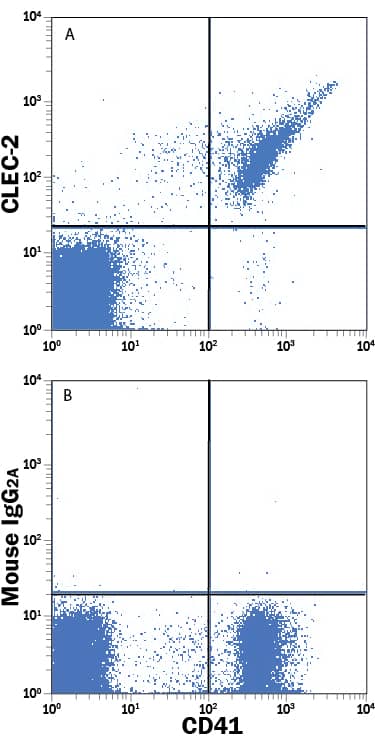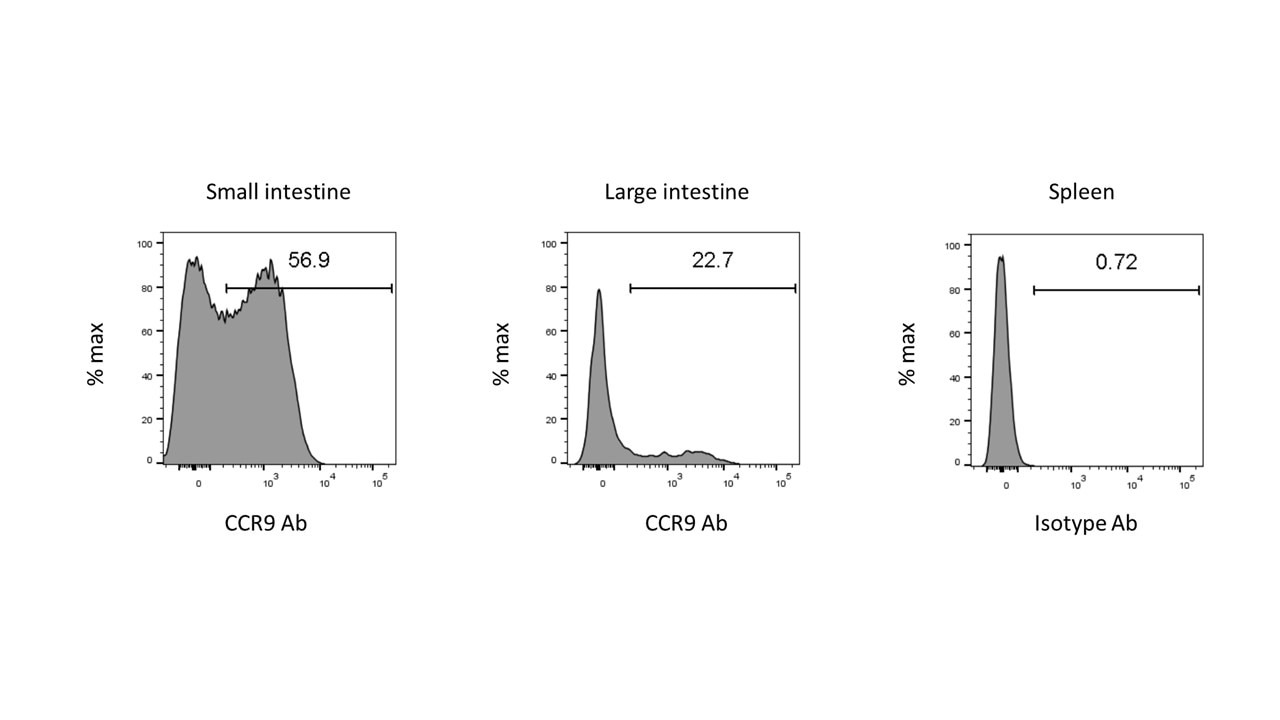Mouse CCR9 Antibody Summary
Met1-Leu369
Accession # Q9WUT7
Customers also Viewed
Applications
Please Note: Optimal dilutions should be determined by each laboratory for each application. General Protocols are available in the Technical Information section on our website.
Scientific Data
 View Larger
View Larger
Detection of CCR9 in Mouse Thymocytes by Flow Cytometry. Mouse thymocytes were stained with Rat Anti-Mouse CCR9 Monoclonal Antibody (Catalog # MAB2160, filled histogram) or isotype control antibody (Catalog # MAB0061, open histogram) followed by Goat anti-Rat IgG APC-conjugated Secondary Antibody (Catalog # F0113). View our protocol for Staining Membrane-associated Proteins.
Preparation and Storage
- 12 months from date of receipt, -20 to -70 °C as supplied.
- 1 month, 2 to 8 °C under sterile conditions after reconstitution.
- 6 months, -20 to -70 °C under sterile conditions after reconstitution.
Background: CCR9
CCR9 is a G protein-linked seven transmembrane domain chemokine receptor that serves as a receptor for CCL25/TECK. CCR9 is expressed on mature and immature thymocytes and some peripheral T and B cells.
Product Datasheets
Citations for Mouse CCR9 Antibody
R&D Systems personnel manually curate a database that contains references using R&D Systems products. The data collected includes not only links to publications in PubMed, but also provides information about sample types, species, and experimental conditions.
9
Citations: Showing 1 - 9
Filter your results:
Filter by:
-
Gut memories do not fade: epigenetic regulation of lasting gut homing receptor expression in CD4(+) memory T cells
Authors: BA Szilagyi, J Triebus, C Kressler, M de Almeida, S Tierling, P Durek, M Mardahl, A Szilagyi, S Floess, J Huehn, U Syrbe, J Walter, JK Polansky, A Hamann
Mucosal Immunol, 2017-02-15;0(0):.
Species: Mouse
Sample Types: Whole Cells
Applications: Flow Cytometry -
Beta 1-integrin ligation and TLR ligation enhance GM-CSF-induced ALDH1A2 expression in dendritic cells, but differentially regulate their anti-inflammatory properties
Sci Rep, 2016-11-29;6(0):37914.
Species: Mouse
Sample Types: Whole Cells
Applications: Flow Cytometry -
Retinoic acid primes human dendritic cells to induce gut-homing, IL-10-producing regulatory T cells.
Authors: Bakdash G, Vogelpoel L, Van Capel T, Kapsenberg M, de Jong E
Mucosal Immunol, 2014-07-16;8(2):265-78.
Species: Mouse
Sample Types: Whole Cells
Applications: Flow Cytometry -
TLR activation excludes circulating naive CD8+ T cells from gut-associated lymphoid organs in mice.
Authors: Heidegger S, Kirchner S, Stephan N, Bohn B, Suhartha N, Hotz C, Anz D, Sandholzer N, Stecher B, Russmann H, Endres S, Bourquin C
J Immunol, 2013-04-15;190(10):5313-20.
Species: Mouse
Sample Types: Whole Cells
Applications: Flow Cytometry -
E2A proteins promote development of lymphoid-primed multipotent progenitors.
Authors: Dias S, Mansson R, Gurbuxani S, Sigvardsson M, Kee BL
Immunity, 2008-07-31;29(2):217-27.
Species: Mouse
Sample Types: Whole Cells
Applications: Flow Cytometry -
Vitamin A metabolites induce gut-homing FoxP3+ regulatory T cells.
Authors: Kang SG, Lim HW, Andrisani OM, Broxmeyer HE, Kim CH
J. Immunol., 2007-09-15;179(6):3724-33.
Species: Mouse
Sample Types: Whole Cells
Applications: Flow Cytometry -
Intervention of MAdCAM-1 or fractalkine alleviates graft-versus-host reaction associated intestinal injury while preserving graft-versus-tumor effects.
Authors: Ueha S, Murai M, Yoneyama H, Kitabatake M, Imai T, Shimaoka T, Yonehara S, Ishikawa S, Matsushima K
J. Leukoc. Biol., 2006-10-19;81(1):176-85.
Species: Mouse
Sample Types: Whole Cells
Applications: Flow Cytometry -
Coordination between CCR7- and CCR9-mediated chemokine signals in prevascular fetal thymus colonization.
Authors: Liu C, Saito F, Liu Z, Lei Y, Uehara S, Love P, Lipp M, Kondo S, Manley N, Takahama Y
Blood, 2006-06-29;108(8):2531-9.
Species: Mouse
Sample Types: Whole Cells
Applications: Flow Cytometry -
A genetically-encoded crosslinker screen identifies SERBP1 as a PKCepsilon substrate influencing translation and cell division
Authors: Martini S, Davis K, Faraway R Et al.
Nature communications
FAQs
No product specific FAQs exist for this product, however you may
View all Antibody FAQsIsotype Controls
Reconstitution Buffers
Secondary Antibodies
Reviews for Mouse CCR9 Antibody
Average Rating: 5 (Based on 1 Review)
Have you used Mouse CCR9 Antibody?
Submit a review and receive an Amazon gift card.
$25/€18/£15/$25CAN/¥75 Yuan/¥2500 Yen for a review with an image
$10/€7/£6/$10 CAD/¥70 Yuan/¥1110 Yen for a review without an image
Filter by:










